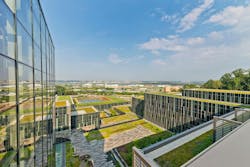Regenerative design examines how buildings and products can be designed to minimize their environmental impact and improve the health of ecosystems. It is the next step in sustainability and was the topic of a recent LinkedIn Live with Sean Quinn, HOK’s director of Regenerative Design, and Microsoft’s JoAnn Garbin, director of Innovation within CO+I Advanced Development.
Their discussion yielded many insights about how regenerative design is being applied today to improve innovation and conservation and how it might evolve. Key takeaways from their conversation included:
1. Regenerative design is inherently optimistic
Quinn and Garbin both spoke about the promise of regenerative design to correct past mistakes and improve future outcomes.
“Regenerative design is about asking how we can give new life to what has been depleted and move forward with nature-positive results,” said Quinn.
“Regenerative design forces us to ask different questions,” said Garbin. “Instead of asking how we do less bad, we ask how we can do more good? In efficiency and optimization, we’re often looking toward minimization. With regenerative design, it’s about net positive abundance and maximization.”
2. Regenerative design is quantitative and adaptive
Data plays a crucial role in regenerative design as it is used to benchmark existing strategies and model new solutions.
“The same way we use data to understand and predict how buildings are going to function for 40 or 50 years, we can apply to nature and the outdoors. We can look at how the soil will sequester carbon emissions or how the trees are going to provide better air quality,” said Quinn. “We can use data to take processes like artificial intelligence and digital twins to optimize the environmental systems both within and outside a building. …We don’t want to just blur the boundaries between the indoors and outdoors. We want to eliminate that boundary entirely.”
“When you build that data modeling in a systems way from the start, it changes the whole lifecycle of what you’re putting into the world,” added Garbin. “It just fundamentally changes the direction you’re coming from and where you end up because of it.”
3. Regenerative design is iterative and collaborative
No single company or individual has all the answers. Uncovering new regenerative solutions requires knowledge-sharing across industries and stakeholders. Both Microsoft and HOK participate in Biomimicry 3.8’s Project Positive, which brings companies together to apply new methodologies to achieve climate goals. But you don’t need to belong to any particular group to experiment with regenerative design.
“Start by asking simple questions,” said Garbin. “What if my product or service was regenerative? What would that look like? Get to the whiteboard and sketch out ideas. …The critical thing to understand about regenerative design and the biomimetic process is that we’re not just designing things to look like nature. It’s about understanding the processes of what nature does, then creating systems to mimic those processes and have similar outcomes.”
Quinn stressed the need to take questions and discoveries to outside teams, peers and even competitors.
“We are so protective of intellectual property, and I understand that,” said Quinn. “But with a challenge as big as climate change, we cannot retreat to our silos and hope to solve the problem. We need to share our insights across disciplines and teams so everyone can weigh in and communicate. It’s in that interchange that we find the best possible solutions.”
4. Regenerative design can be practiced on the micro or macro scale
Projects and products large and small can aspire to be regenerative. Quinn gave the example of how regenerative design could be applied to a single building block, such as a brick made from compacted mushrooms, or a larger and more complex project such as the 1.2 million-sq.-ft. U.S. Coast Guard Headquarters in Washington D.C., which was designed to return clean water to the nearby Anacostia River.
“At the time it was built, the headquarters had one of the largest green roofs in the country,” said Quinn. “As rain falls on the building, it descends over a series of cascading green roofs that slowly filter the water. That water then feeds into the Anacostia River that has been horribly depleted over the course of the past century.”
5. Regenerative design presents an opportunity and a challenge
No one solution will restore the balance between nature and the built environment. That’s what makes regenerative design such an intriguing design challenge, said Garbin.
“As innovators, we have the responsibility to look beyond what’s just being asked to what is actually needed,” she said. “If we have the privilege of creating the future, then we must also create the future we want. To me, regenerative design is another tool that helps us achieve that.”
